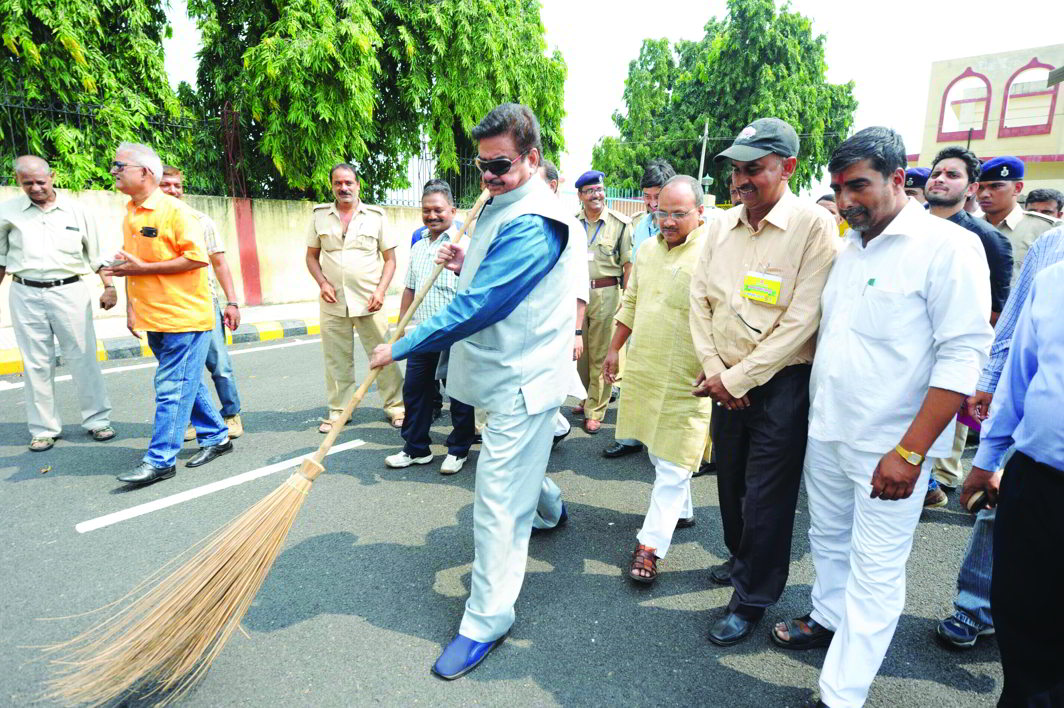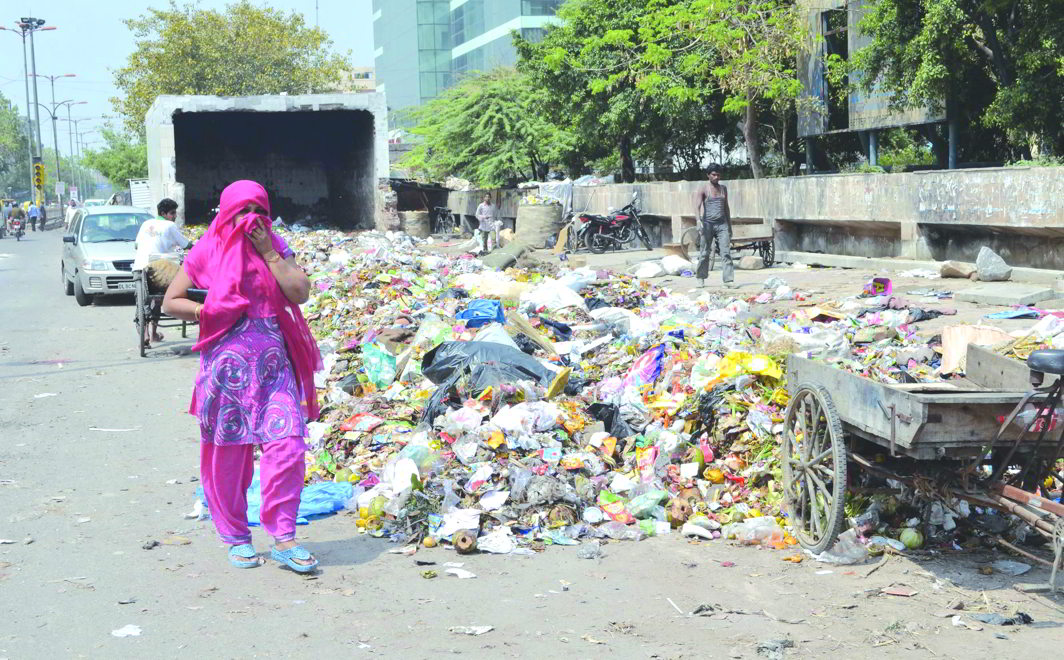India is a country groaning under garbage with some 1,00,000 tonnes being generated every day. Despite various laws to tackle the rubbish, it has not made a dent in the way Indians behave

~By Bikram Vohra
If VIPs wish to pick up brooms and engage in the optics of a well-organised photo op, so be it. At least they are sending a correct message even if those 20-odd minutes of futility won’t go very far in cleaning up 65,000 tonnes of garbage produced by urban India every day.
Add the rural contribution and that figure hits 1,00,000 tonnes every 24 hours, according to media reports. Over three million trucks fling the waste in a disorganised and unhygienic manner into the sea or groaning landfills that cannot take it anymore. If you take a look at our streets, you would be hard put to believe we have written laws for removing and destroying garbage
We actually have a whole slew of laws intended to protect and preserve the environment and ourselves. But there is no Erin Brockovich taking on the corporate polluters and our courts seldom if ever take on these issues or breaches of the legal fiats. As per Rule 4 of the Municipal Solid Wastes (Management and Handling) Rules, 2000, “every municipal authority is responsible for infrastructure for segregation and processing of municipal solid waste (MSW), commonly known as garbage”. But it is as effective as a wet noodle.

Of the 40,000 tonnes of plastic produced daily, nearly 40 percent fails to get recycled and adds to the suffocation of Mother Earth. The Plastic Waste (Management and Handling) Rules, 2011, are integrated in a regulatory framework set up to control the use, manufacture, and recycling of plastic waste. Rule 9 makes it compulsory for manufacturers of plastic products and recyclers to obtain registration from the State Pollution Control Board. Rule 10 states that no retailer can provide plastic bags free of cost.
The concept of selective deposit of recyclable and degradable materials is non-existent. A Business Standard survey indicates that nearly 40 percent of garbage is paper and it blankets the country. As far as glass is concerned, as much as 55 percent goes into the earth to lie there for centuries. No wonder our beaches are a hazard strip. A sobering reflection: according to the United Nations Development Programme, up to 40 percent of the food produced in India is wasted and turns into garbage. If you go by bhookh.com, over 20 crore Indians will sleep hungry tonight. In 2011, India introduced the food wastage law but it withered on the vine.
A billion batteries are thrown away every year and the figure can only increase as financial liquidity and EMIs offer goodies to over a billion people. The indifference to corrosive materials leads to acid, nickel, cadmium, silver, cobalt, mercury and lead leaching into the ground.

The Batteries Rules of 2001 apply to every manufacturer, recycler, dealer, importer, assembler, bulk consumer (like organisations and departments purchasing over 100 batteries) and consumers. Yet, there is no stopping the bleeding into the earth.
According to the US Agency for Toxic Substances and Disease Registry, cadmium can cause lung damage, kidney disease and death, while lead can damage the kidneys, nervous system and reproductive system.
Prescription meds, both capsules and syrups, bandages, soiled linen, sanitary napkins, all sorts of bio-medical waste leak into the water supply. The Bio-Medical Waste (Management and Handling) Rules, 1998, are ostensibly to ensure that these wastes are safely disposed of. Bio-medical waste covers any waste or byproduct generated during treatment, immunisation and treatment of human beings or animals or in research activities, but it is totally ineffective.
The three-year-old clarion call by Prime Minister Narendra Modi can hardly be faulted. To make it succeed, mindsets have to undergo a thorough transformation. But he cannot win this war through good intentions. Each one of us has to be a soldier to make it happen. How far back are we in the third year of this race to clean up? There are 2,200 “waste to energy” conversion systems in the world and we have only eight such plants.
The fact is we are a super clean people in so far as we can dirty up the space around us in achieving this goal. Look at the ledges of urban buildings. They are choked with debris, baking in the sun, sogging in the rain. See the housewife assiduously sweep her home clean and then fling the pan of muck over the wall. Drive with an executive in his upmarket car and he thinks nothing of flinging the half-eaten sandwich on the road along with a can of soda that almost hits the car behind and makes that driver swerve dangerously. A truck on the highway spilling half its contents through the split seams of its container. Who cares?

We want our rivers and ponds and lakes dredged and cleaned. First we must stop defecating in them, bathing in them, giving E Coli and other infestations which are magnificent breeding grounds. Neither our gods nor nature has decreed that we pollute running waters with ashes of our dead and the clay idols of our worship. Think of it…even TB is back and it was one of the empirical cures in medical science.
Spitting, hacking, coughing, peeing, all of these are part of the problem and Modi’s best intentions are mere cardboard against the wilful nature of man. Come winter and smokestacks will belch muck into the air aided by roadside fires to keep the chill away. This will see acrid smoke choking the already dangerously polluted air in our cities. Illnesses will rise exponentially.
Dirty water, filthy air, contaminated spaces, this is the legacy for our children and it is showing. Asthma, influenza, multiple sclerosis, chest congestions, pneumonia and throat ailments have all spiked in children. According to WHO, 30 million Indians suffer from asthma. And what adds most to waste? Our habit of wasting.
How can waste ever be good? Look at the food that goes into the garbage. Over two kilos per person per day, although in 2013 it was marked at a little less by the International Solid Waste Association. Countries creating the highest amounts of waste were China, followed by the US and India. It is estimated that a person creates waste of around three times their own weight, which means that on an average, 271.7 kg of garbage per person was generated then and would probably be higher now due to increased consumerism.
Go to your fridge again and pull out all the stuff that has expired. See how much it had cost you and you never used it. Half bottles of pickles and relish, sauces by the dozen, congealed cups of ice-cream, dried rind of cheese, cucumbers with mold, all to be thrown away. What a waste.
Clothes you’ll never wear, jamming your cupboards. Bric-a-brac stuffed into spaces because they were replaced on the decor pyramid years ago but you never got rid of them. A storeroom full of dust-covered books no one will read, dated magazines, never to be opened but an invitation to white ants.
There is that silly hoarding habit. Meds that have expired, video movies that will never enter a VCR because they don’t make them anymore, old computer screens that don’t work, cracked mobile phones, broken chairs and tables, suitcases choked with stuff of no value.
Our e-waste problem is real. But there is no organised system for disposal despite the E-Waste (Management and Handling) Rules saying that such a system should be there.
So we end up depositing some 18.5 lakh tonnes of electronic rejects into the garbage annually without a care, making India the fifth largest e-waste nation globally.
The one constant in all this is the law flouting all these laws.


